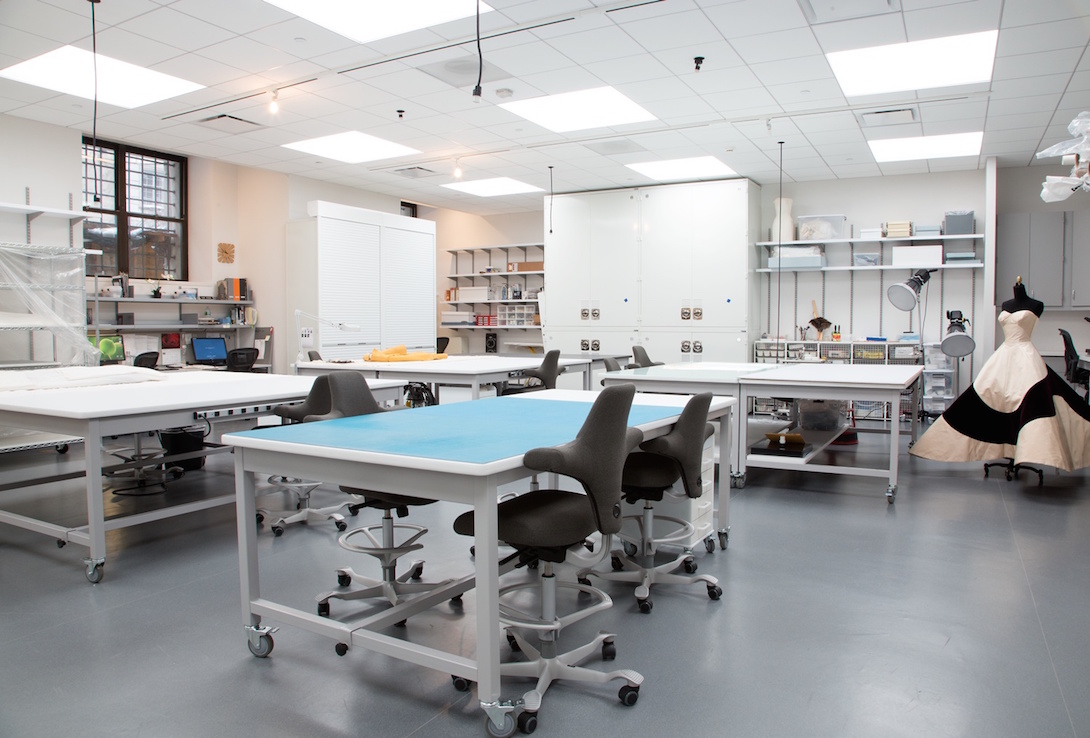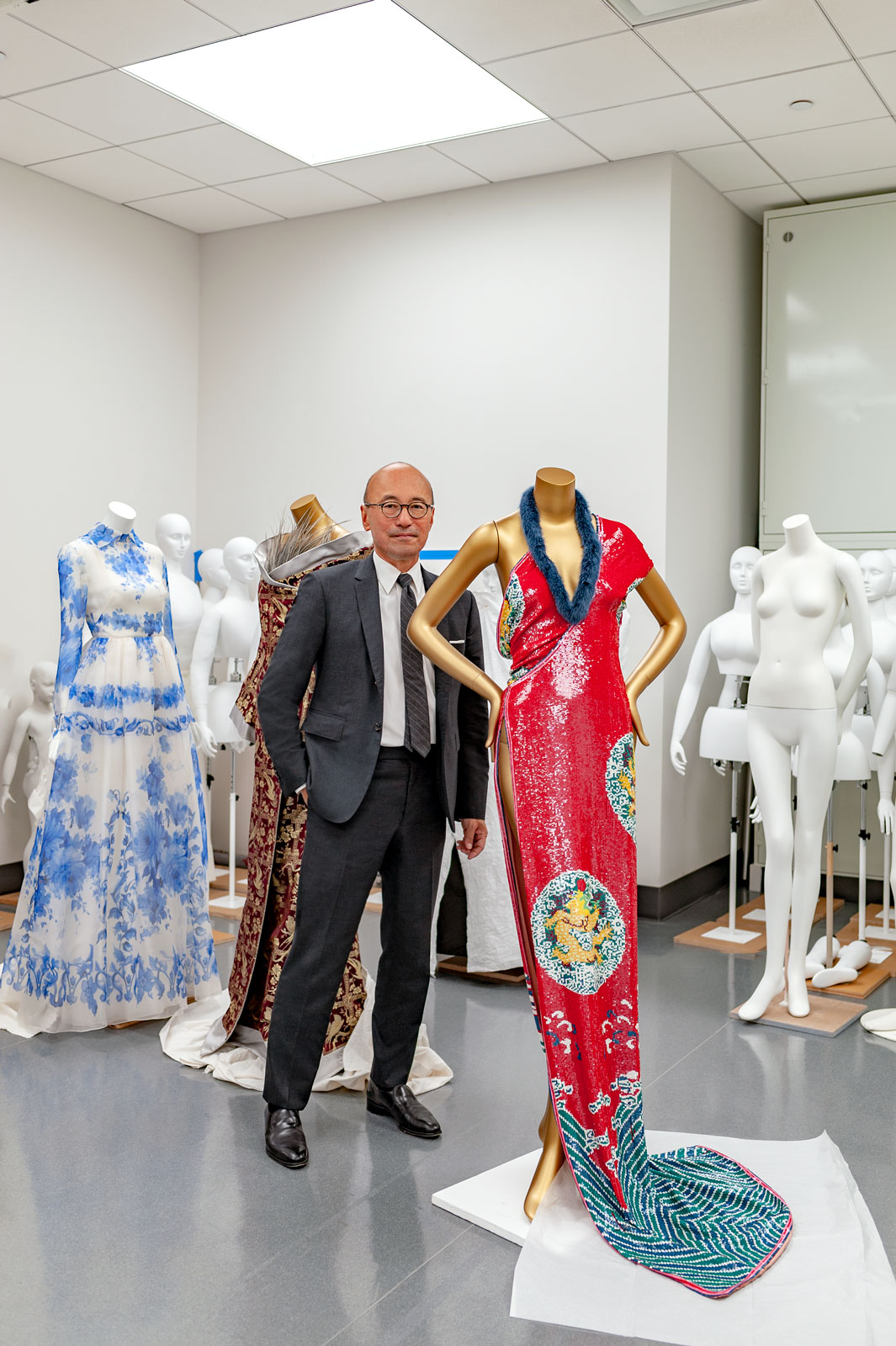He wears a perfectly tailored suit, round glasses and polished shoes. With neither pride nor pretension, he stands next to three dress forms and smiles with modest assurance. He is showing three examples of design suffused with Asian references: an ethereal Valentino dress designed by Maria Grazia Chiuri and Pierpaolo Piccioli (a/w 2013/14) in shades of white and cobalt blue evoking the Yuan dynasty porcelain, a bright red dress with a fur neckline from Tom Ford’s last collection for YSL Rive Gauche (a/w 2004/5), and a muted gold brocade dress by Alexander McQueen for Givenchy (a/w 1997/98). All are to be included in the Spring 2015 exhibition China: Through the Looking Glass. In the background a dozen naked dress forms stand like troops in military formation as if they were waiting for their commander’s orders. The man in the picture is Harold Koda, Curator in Charge of the Costume Institute of the Metropolitan Museum of Art.

But let me take you to a library in the ground floor of the Metropolitan Museum of Art. First, we must pass the dimly lit galleries that hosted the now completed Charles James: Beyond Fashion exhibition. The mannequins have been removed and only the name of the Anglo-American couturier, “the greatest talent of my generation” according to Christian Dior, has remained on the wall. From this obscurity, which also characterizes the last days of James, who died in poverty at the Chelsea hotel in 1978, the door opens to a brighter room, the library of the Costume Institute. There, a life-sized doll sculpture by Greer Lankton of the illustrious editor and curator Diana Vreeland, who for seventeen years served the Costume Institute as Special Consultant, stands next to the reading tables looking rather grim in her leopard printed dress.
The Honolulu-born Koda had the opportunity to work alongside the maverick Vreeland as an exhibition assistant for exhibitions such as The Glory of Russian Costume (1976), and Vanity Fair (1977). “The first thing that I noticed about herwas her preference for the individual, the idiosyncratic, the eccentric, even the odd. She said that even vulgarity was the paprika of life, the spice that made everything more vivid.” Koda speaks slowly and low making every word count. He takes pauses of several heartbeats in between sentences and his deep voice projects an aura of confidence. When he elaborates on technical details, he has a certain kind of wisdom, and even though he does not consider himself an academic or intellectual, he definitely has a scholarly charm.
Vreeland’s attitude to fashion was unapologetic and extravagant, but none of the excess that characterized her seems to have spattered on him, or at least none that can be witnessed on the surface. He sits with perfect posture in his well-organized office filled with numerous catalogues, and with a voice not betraying an emotion, says, “We can no longer do shows like she did back then. Diana Vreeland’s exhibitions were extraordinary and enthralling, but sometimes ahistorical fictions. Today the public is more informed about fashion history and demands more. If we dared to reproduce her exhibitions now, we would be laughed out of the city.” Still, dazzled and inspired by the audacity of Vreeland, Koda went on to curate fascinating shows with probably less fantastical excess, but equal zest.
Koda walks with me to the Department’s brand new storage facility with floor-to-ceiling sliding closets and embedded temperature and humidity indexes. Here are housed the combined holdings of the Met and the Brooklyn Museum Costume Collection. With a push of a button the enormous closet slides to the left and reveals hidden treasures like Alexander McQueen’s “oyster dress” (s/s 2003) with hundreds of layers of ivory silk chiffon organza, a Yohji Yamamoto wedding dress (s/s 2000) made of natural cotton muslin and ivory silk jersey with large laser-cut holes, and a Jean Paul Gaultier long Grecian burgundy colored gown (s/s 2003). “Gaultier’s fashion provocations are invariably leavened with humor, even when he is inspired by Hellenic art,” wrote Koda in his book Goddess: The Classical Mode, the volume that accompanied the 2003 Met exhibition. The collection also includes, Dutch fashion designer Iris Van Herpen’s 3-D printed skeleton dress. Speaking of this unusual “gem,” Koda says, “We knew that this was the beginning, the touchstone for a whole transformation of how we consider the making of clothing. Iris is using the latest advances in technology, yet she is a poet.” If Vreeland had the opportunity to work with such a piece, “I am sure she would have done something remarkable. As long as it has an aspect of something new, something that makes women appealing, creates mystery and desire she would embrace it. I can imagine her with somebody like Veruschka or Marisa Berenson naked on the beach like a dead seagull stretched on the sand.”


Gazing admiringly at the collection, Koda says that most of it traditionally came from donations. “Fashionable women who indulged in either the avant garde prêt-à-porter or the haute couture donated some of their best pieces to the Met, but increasingly the most interesting and directional designs in fashion are no longer items that will ever come onto the retail market. Take, for example, the Hussein Chalayan Airplane dress (s/s 2000) made of fiberglass and metal. It is unwearable, but we still wanted to include it in our collection, because it says something about the cutting-edge thinking of the moment.” What troubles him, though, is that “we focus on getting the showstoppers for the collection or an exhibition at the expense of the more representative and quotidian…a suit, for example, from the wardrobe of the professional or career woman, clothes not intended for a ball or the red carpet. What does she wear?” Unfortunately, what a female CEO would wear doesn’t arrest the attention of most museum-goers. It looks too similar to what they have in their closets. To the contrary, fantasy clothing instantly attracts an audience, and he credits part of the reason for the success of the Charles James show to that very fact. “Nobody goes to a ball anymore or wears a dress that is 6 feet wide. There is a kind of compelling fantasy aspect to that kind of object.” But it is also the mission of The Costume Institute to reflect its place in an encyclopedic art museum. The department is directed to collect major aesthetic achievements in its assigned curatorial métier. In some instances, “real” clothing can be highly conceptual design or representative of important technical and aesthetic innovation, but true masterworks of costume in the world of retail fashion are, frankly, rare.
In the costume conservation laboratory, staff in white clinical robes work meticulously on garments. All furniture is on wheels to allow easy reconfiguration of the workspace and fit gowns as wide as James’s exquisite Clover Leaf Gown made of white silk satin and faille and black silk-rayon velvet. Arm mounted magnifiers are used for precision work and studying the refinement and delicacy of decorative detailing found in garments like Elsa Schiaparelli’s beautifully embellished evening jackets. Schiaparelli jackets were used in the 2012 Schiaparelli and Prada: Impossible Conversations show and were paired with Prada skirts, in an attempt to emphasize how one designer directed the embellishment on the top part of the body while the other on the lower part. Koda says that in his first job as an intern in the Costume Institute he worked for the restorer, Elizabeth Lawrence. “At the time volunteers, mostly privileged society women, would come in to work on the dresses and on the shows. Now, the approach to conservation has become much more scientific and only professionally trained people are allowed to work on the garments.”

Koda moved in a persevering manner to the top of the Met. From intern then exhibition assistant at the Costume Institute at the Met, he moved in 1979 to become associate curator at the Design Laboratory of the Fashion Institute of Technology (FIT) where, together with the late Richard Martin, curator in charge, he worked on various successful shows. In 1993 they jointly moved to the Met creating twelve acclaimed exhibitions, but in 1997 Koda decided that he needed a break from fashion and left to do a Master’s degree in landscape architecture at Harvard University. In 2000 he co-curated the Giorgio Armani exhibition at the Guggenheim Museum and rejoined the Met as curator in charge.

Increasingly the most interesting and directional designs in fashion are no longer items that will ever come onto the retail market.
Harold Koda
Even though Karl Lagerfeld famously called the Met the Necropolitan Museum of Art because it’s all about the past, every spring the still waters of the Costume Institute are stirred by a benefit that celebrates the opening of the spring show and makes it all about the present. Koda provides a little history. “The fund raising event was established in 1947 by Eleanor Lambert, the legendary fashion publicist, in an attempt to raise money for exhibitions, acquisitions, and capital improvements.” Movie stars, fashion moguls and celebrities flood the museum for a night, some of them wearing creations inspired by the theme that the Costume Institute has set that year. This year, the Costume Institute will collaborate with the Department of Asian Art and high fashion will be juxtaposed with Chinese costumes, paintings, porcelains and Chinese films.
While the Met turns the spotlight on the Costume Institute, Koda refrains from whatever would attract attention to him. “You should be interviewing Andrew (Bolton, curator at the Costume Institute) and not me,” he says as he adjusts a gown on the mannequin. The gown, at once piquant and elegant, is Koda’s favorite piece. The moment he starts interacting with the dress, any suggestion of modesty in his appearance is overturned by the control, the strength and confidence of his every movement. Keeping his eyes fixed on the mannequin, he is outwardly calm, but the intensity of sheer virtuosity becomes palpable, and it looks like Koda’s command of choreography is an undisputed fact. While performing this delightful ritual, he speaks. “Shows should enlighten, educate, introduce new ways of considering the familiar, and at their most successful elicit strong emotions and unexpected critical thinking.”

New York, 2014. All photographs, unless stated otherwise, and text © 2014 Alexia Antsakli Vardinoyanni – www.artflyer.net



